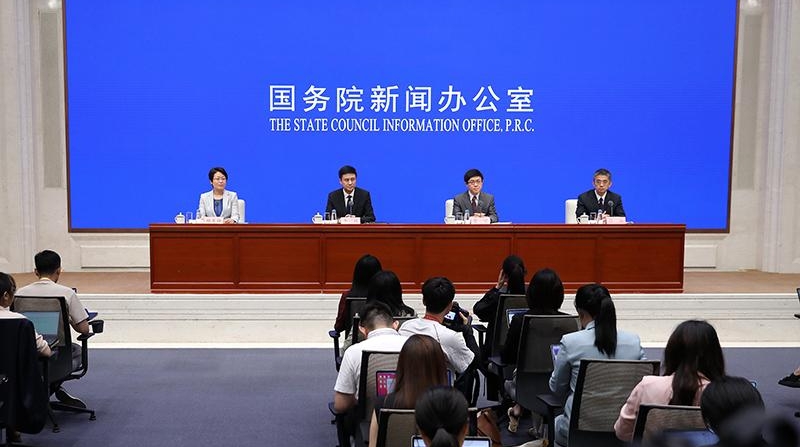CCTV:
As a major open economy, China's balance of payments situation has received widespread attention. Could you introduce the characteristics of China's international balance of payments in recent years? Thank you.
Li Bin:
I would like to invite Mr. Jia to answer this question.
Jia Ning:
Thank you for your interest in the balance of payments situation. The balance of international payments is a summary and record of various economic transactions between residents and non-residents. It includes the current account, which records cross-border goods trade, service trade and investment income, and the capital and financial accounts, which record cross-border investment and financing. Through the balance of international payments and international investment position statement, a country's external economic development and internal and external economic balance can be comprehensively reflected. I will share two aspects with you regarding the changes in China's current account, capital account and financial account in recent years:
First, in recent years, China's current account has been operating steadily. China's current-account surplus mainly comes from surplus in goods trade. Since 2020, China's trade surplus in goods has increased, which is attributed to changes in internal and external factors. In recent years, global demand for goods has increased, with an average annual growth rate of 5.8% in global goods imports from 2020-2024, higher than the average annual growth rate of 0.7% from 2015-2019. Driven by this, China's exports have grown rapidly, and imports have also increased. According to preliminary statistics, in the first half of this year, the trade in goods under the balance of payments framework increased by 2.4% year-on-year. In addition, the trade in services has become more active, and the overall deficit has narrowed. China's international competitiveness in producer service trade such as computer information services and commercial services has improved. At the same time, China continues to optimize services for foreigners coming to China and expand visa facilitation, which has increased the popularity of China as a tourist destination for foreign visitors. Supported by this, in recent years, China's trade in services receipts have steadily expanded, and payments have maintained steady growth, leading to an overall narrowing of the deficit. In the first half of this year, trade in services receipts increased by 13% year-on-year, with cross-border travel receipts surging by 42%. Meanwhile, trade in services payments grew by 2%, leading to a decrease of 14% in the service trade deficit. Furthermore, China's investment income deficit has gradually declined from the high level in 2022, which has also contributed to promoting stability of the current account. From January to May this year, investment income continued to improve, with foreign investors' returns in China increasing by 17% year-on-year, and China's overseas investment income increasing by 12%, keeping the investment income deficit basically stable.
Over the past three years, the ratio of China's current account surplus to gross domestic product (GDP) has been around 2%. In the first quarter of this year, the current account surplus reached $165.4 billion. Preliminary estimates suggest that the surplus narrowed in the second quarter. These suggest that the surplus-to-GDP ratio generally remains within a reasonable and balanced range.
Second, the deficit in China's capital and financial accounts has contributed to the accumulation of external assets, with China's balance of payments maintaining a stage of equilibrium. A current account surplus signifies that China obtains capital inflows from abroad through exports of goods. Capital inflows are also generated by foreign direct investment(FDI) from overseas entities, as well as their purchases of domestic stocks and bonds. At the same time, various domestic entities such as enterprises and financial institutions also generate external assets through capital deployment such as outward investments. From the perspective of the macroeconomy and balance of payments, the growth in the current account surplus will inevitably entail a corresponding expansion in the capital and financial account deficit. Therefore, expansion of the capital and financial account deficit cannot be simply interpreted as an increase in capital outflow pressure. Based on China's conditions, the widening deficit in the capital and financial accounts in recent years has mainly been due to the increase in outward investment by domestic entities, while foreign investment in China has generally maintained net inflows.
Investment in China by overseas institutions has given rise to China's external financial liabilities, while investments by domestic entities abroad have formed China's external financial assets. As of the end of March this year, China's external financial liabilities were $7.1 trillion, reflecting the effectiveness of our efforts in utilizing foreign capital and attracting foreign holdings of RMB-denominated assets. During the same period, China's external financial assets amounted to $10.7 trillion, with diverse asset types and holding entities. After offsetting assets against liabilities, net assets stood at $3.6 trillion, which also reflects the results of our active participation in international economic circulation.
Looking ahead, China's economic structure will continue to improve; internal and external equilibrium will be strengthened; and the two-way financial market opening will be advanced steadily. These will support a basic equilibrium of balance of payments. That's all for my introduction. At the end of March and September each year, we release the "China Balance of Payments Report" on SAFE's official website, which is available for your reference. Thank you.


 Share:
Share: 




 京公网安备 11010802027341号
京公网安备 11010802027341号